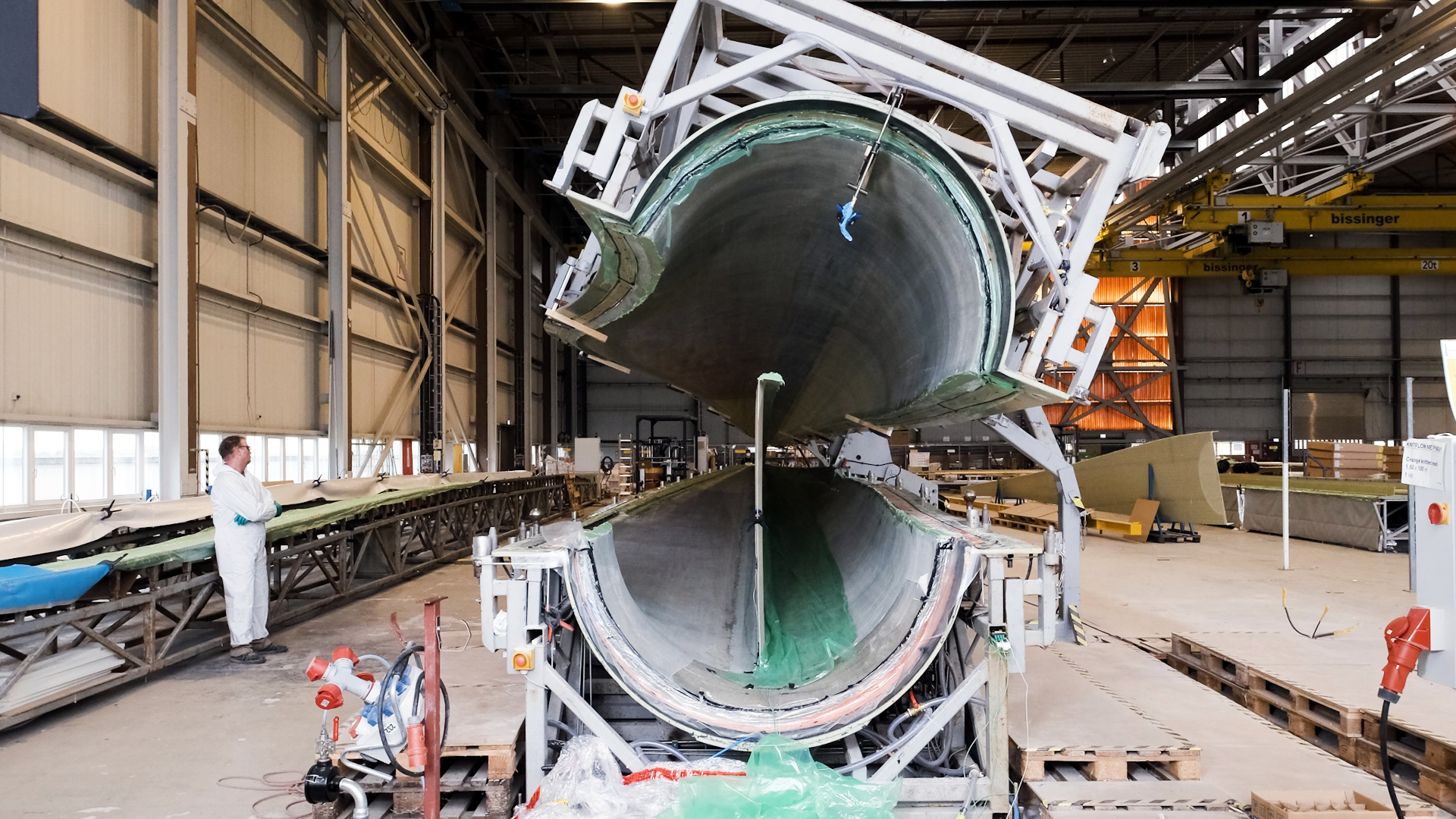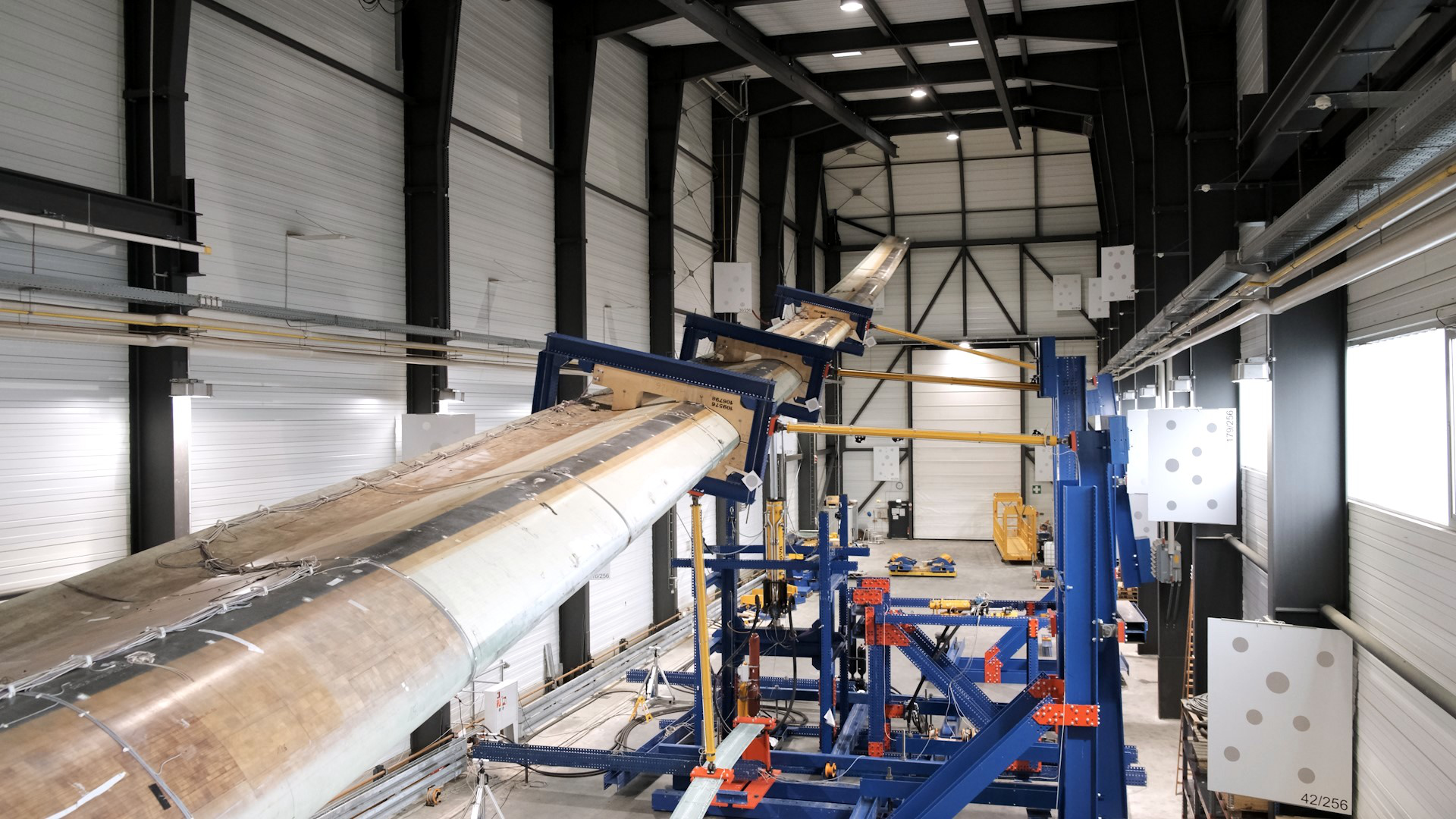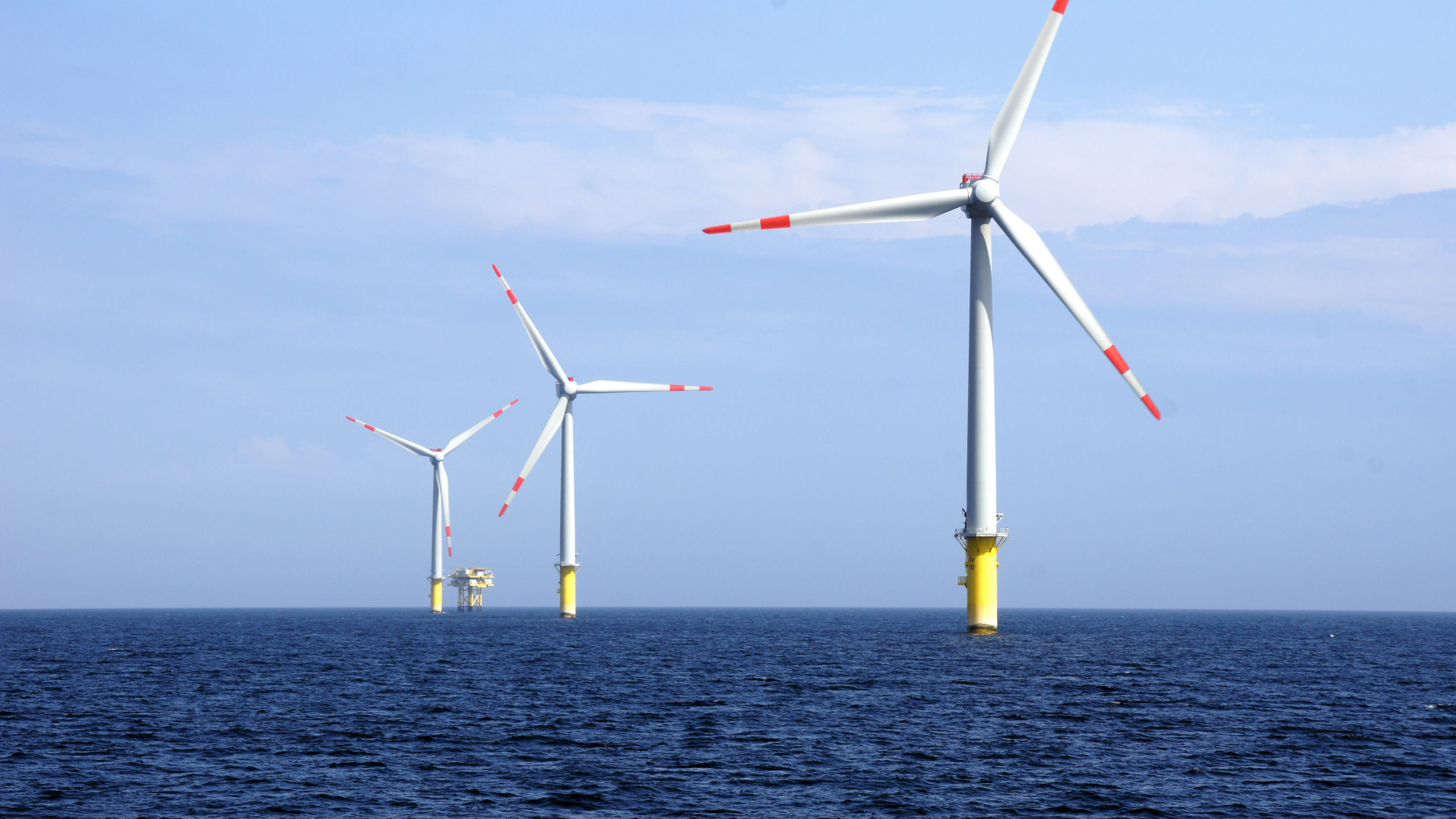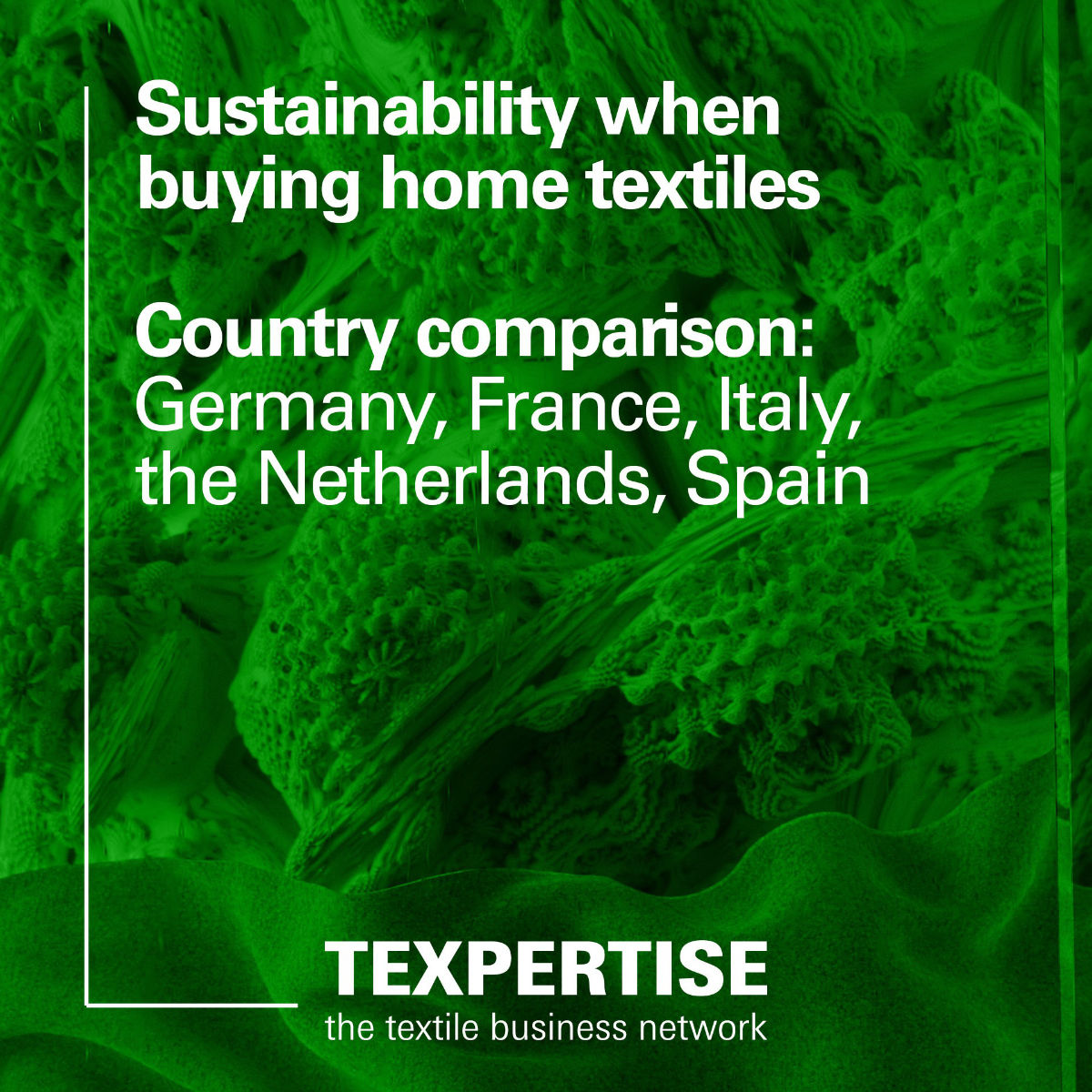For Steffen Czichon, it is only logical that the rotor blades of the vast majority of the world’s 350,000 plus wind turbines are made of fibres rather than alloys. “To be honest, we never thought to go through the calculations,” he says, somewhat puzzled, when asked why rotor blades are not made from an alloy such as aluminium. Instead, glass or carbon fibres are bonded with epoxy resin to create glass-fibre-reinforced plastic (GRP) or carbon-fibre-reinforced plastic (CFRP).

Going with the wind – at speeds of up to 300 kilometres per hour
And Czichon ought to know. As head of the Rotor Blades department at the Fraunhofer Institute for Wind Energy Systems (IWES) in Bremerhaven, he works at one of the world’s leading wind energy research institutes. Renowned wind turbine manufacturers from all over the world have their rotor blades tested here. “We test materials and manufacturing processes and take a close look at how rotor blades behave under load,” says Czichon. One important test is the dynamic fatigue test. It is used to test whether the rotor blade can withstand continuous wind loads over its service life of more than 20 years and reliably supply green electricity throughout that period. This involves artificially vibrating the rotor blade and moving it up and down around the clock for several months. Because of their low material fatigue, GRP and CFRP can withstand millions of these load changes without breaking, unlike many other materials. The following figure shows how great the load on rotor blades is in real-life operation: in strong wind, the tips of the blades rotate at speeds of up to 300 kilometres per hour – the speed of a Formula 1 racing car.
Rotor blade production is (still) manual work
It will come as no surprise to anyone in the textile industry that rotor blades can withstand such extreme forces very well, even though they contain small glass and carbon fibres that are thinner than a human hair. GRP and CFRP have long been featured as technical textiles at many of the more than 50 textile trade fairs around the world in the Texpertise Network. Representatives from the fields of aerospace, automotive engineering and mechanical engineering, among others, regularly find out about the latest fibre composite developments there. GRP and CFRP are valued in these industries for the same reasons as they are by wind turbine manufacturers: high load-bearing capacity and high strength combined with low weight.
Because the demand for fibre composites continues to increase due to the global expansion of wind power (more on this later), the automated production and processing of fibre composites is now also playing a role at many Texpertise trade fairs. “In terms of faster rotor blade production, we’re definitely working on that,” says Czichon. One important point is that regardless of whether rotor blades are made of GRP or CFRP, this is still done by hand to this day. For this purpose, individual glass or carbon fibre mats are first layered by hand in two half-shells, in the shape of the finished rotor blade, then impregnated with epoxy resin and – after hardening – folded together to form the finished “rotor blade sandwich”.
All-time high in wind power expansion
Incidentally, a state-of-the-art 5-megawatt wind turbine supplies enough energy to power up to 4,000 households a year. The latest offshore systems, such as those currently in operation in China, are already producing more than three times as much because they are larger and there is more wind there. According to Statista, wind energy accounted for just over 7% of global electricity generation in 2022. A figure that could soon be in double digits. According to the Global Wind Energy Council (GWEC), the global expansion of wind power reached an all-time high last June: for the first time, global installed wind power capacity exceeded the one terawatt mark. According to the GWEC, the two terawatt mark should be surpassed by 2030. By way of comparison: the output of all nuclear power plants currently in operation worldwide is around 0.4 terawatts. For rotor blade expert Steffen Czichon, this is logical: “The global demand for wind turbines has been high for years, and it was always clear that this trend would and must increase in the long term, because climate change is not going away by itself.”

“Rotor blades determine the aerodynamics”
Another aspect that makes GRP and CFRP so popular with rotor blade manufacturers: due to the high flexibility of the glass fibres and carbon fibres, they can be formed into the finished plastic composite in almost any shape prior to hardening. Wind power manufacturers deliberately make the most of this. “It’s the rotor blades that determine the aerodynamics,” says Czichon. “They are therefore directly responsible for how much power a wind turbine delivers.” By cleverly positioning the glass and carbon fibre mats during rotor blade production, the turbine manufacturers ensure that the blades are able to twist in strong winds in such a way that they have less contact surface, according to Czichon. “Skilful fibre positioning can get even more out of the wind turbines,” he says. The fact that GRP and CFRP are also resistant to external influences such as rain, hail and snow – in part thanks to additional coating – is also quite a useful characteristic considering that, measured to the tip of the blade, rotor blades nowadays work in harsh environments at heights of up to 240 metres (the top of the Eiffel Tower in Paris is only 60 metres higher).
Heavy as a blue whale, longer than a football pitch
Rotor blades have become ever longer over the years, in order to continuously increase wind yield. While the first GRP blades from the 1960s were less than 20 metres long, those on modern land-based systems now reach 80 to 100 metres. At sea (offshore), they can even be more than 115 metres – more than the length of a football pitch. “In physical terms, even 200 metres is conceivable,” says Fraunhofer scientist Czichon. It is not unreasonable that such lengths will be reached one day. As recently as June, the German Minister of Economic Affairs, Robert Habeck, inaugurated a new test rig for rotor blades from a length of 115 metres at the IWES.
Incidentally, the longer a rotor blade is, the more likely it is to contain carbon fibres. Because they are significantly stronger than glass fibres, they are better able to withstand the increasing wind forces acting on the rotor blade with greater length. “The loads on the base of the blade grow exponentially with the length of the rotor blade,” explains Czichon. With ever longer rotor blades also naturally becoming heavier and heavier, glass and carbon fibres provide the further benefit that, unlike metallic materials, they are extremely lightweight. Today, a rotor blade weighs up to 50 metric tons despite the lightweight composite material. If you add up the weight of the three rotor blades that are usually found on a wind turbine, they weigh about 150 metric tons, roughly as much as a fully grown blue whale. This shows that the small glass and carbon fibres, which in the form of plastic composites are only about half as heavy as aluminium, will continue to play an important role in wind energy in the future.
Cover picture: Fraunhofer IWES/Gerrit Wolken-Möhlmann










